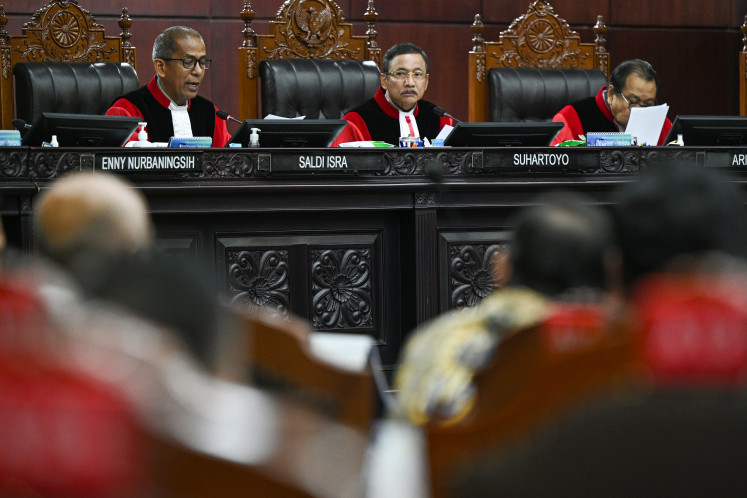Popular Reads
Top Results
Can't find what you're looking for?
View all search resultsPopular Reads
Top Results
Can't find what you're looking for?
View all search resultsA gargantuan feast for the eyes
'What About Sharing', a work by Agus Sudarto, exhibited at “Exposign” in Yogyakarta
Change text size
Gift Premium Articles
to Anyone
'What About Sharing', a work by Agus Sudarto, exhibited at “Exposign” in Yogyakarta.
Now is the time for anyone who wants to witness the journey of Indonesian Fine Arts
in the last three decades to do so.
Commemorating its 25th anniversary, the Indonesian Institute of Arts, ISI Yogyakarta, in collaboration with the Yogya Gallery, is holding “Exposign”, an art exhibition featuring over 600 works from 551 artists of different generations, all alumni of the higher education institution.
Participating artists include prominent figures in both the national and international art scenes, those whose works influence the price of art in the world, like Sumardi Alvi, Handiwirman, Puji Kustarto, Putu Suta Wijaya, Mohamad Irfan, Yunisar, and Nyoman Masriadi.
Other notable artists whose works feature at the exhibition include Affandy, Djoko Pekik, Hendra Gunawan, Made Wianta, Hardi and Bonyong Muniardi.
Dubbed the biggest art exhibition of the century, “Exposign” has taken over 800 square meters of the Jogja Expo Center, JEC Yogyakarta, and will run from Nov. 25 to Nov. 30, 2009.
Most works exhibited are of gigantic proportions, including for example a 3.5-meter-high ceramic, a 7-by-4 meter painting, a 7-meter-tall horse-statue made of fiberglass, a set of eight statues weighing 3 tons each, and a VW car carrying big dolls.
The exhibition aims to highlight trends in creativity, ranging from developing ideas to the media used, with curators Mikka Susanto, Sujud Danarto, Kuss Indarto, Suwarno Wisetrotomo and Gede Arya Sucitra conducting a tight selection process for participating artists.
Mikka Susanto, one of the curators, said high achieving artists who had actively been taking part in exhibitions for the last two years, and who could represent certain styles or departments within ISI Yogyakarta, would be invited to join the exhibition.
“Yet, the prerequisites are very academic since we are now displaying the achievement of an education institute,” Mikka said, adding the challenges facing the curators were not only classifying the artists but their art works as well.
“It is also difficult to classify the artists based on their works, particularly those who changed their styles,” Kuss Indarto, another curator, admitted. However, he added that the 600 art works would give a glimpse of the journey and history of Indonesian visual arts. He also found that the ISI Yogyakarta alumni had dominated the development of the Indonesian art scene thus far.
To guide visitors through this gargantuan exhibition, curators designed a 650-page catalogue, and divided the rooms into different eras, styles and generations of artists.
The first sight greeting visitors to the exhibition is that of Dunadi’s seven-meter-tall horse statue, made out of fiberglass. It took the artist six months to finish this statue consisting of 25 different batik motifs, despite horse “creating” being his trademark.
“The most difficult was putting together the different motifs of batik. That took two months,” said Dunadi, noting that he was not supposed to place high-value batik motif on the lower part of the animal statue. Certain norms have to be respected, he said, especially those pertaining to the Javanese royal hierarchy, dictating that certain batik motifs can only be worn by sultans or other members of the royal family.
Abutting the horse statue is a 3.5-meter ceramic artwork created by Aris BM, who is now a lecturer at ISI Surakarta, Central Java. Next to it is a set of huge limestone statues — portraits of presidents of Indonesia — in which the first president, Sukarno accompanied then-vice president Mohammad Hatta as the founding fathers of the nation.
Inside the hall, visitors will be able to see artworks created by alumni who majored in fine arts as well as in recorded media and visual communication designs.
Donosaurus & Friends on Journey, by Heri Dono.
There are many more statues and three-dimensional art works inside the hall, such as Heri Dono’s Donosaurus & Friends on Journey, a mixed media consisting of a blue VW car carrying white-colored dolls.
The contrast between different generations of artists is apparent, with works from 1960s and 1970s artists Hendra Gunawan and Djoko Pekik — considered left wing — reflecting their rebellious spirit, despite being strongly influenced by academic norms in terms of concept, colors and details. Works from the 2000 generation, on the other hand, tends to be more open to the outer world, consisting of various trans-media works and installations.
— Photos courtesy of Exposign











